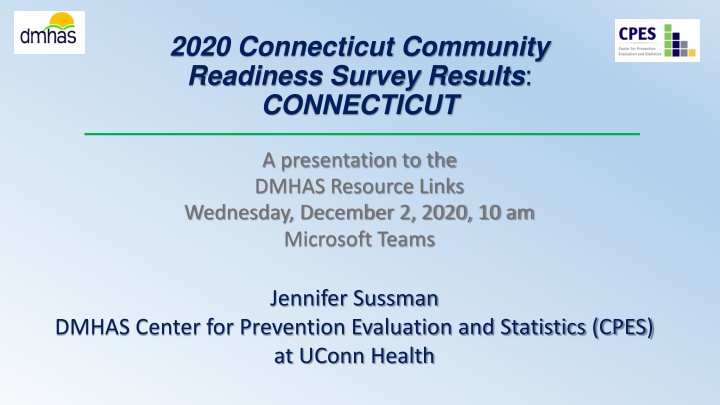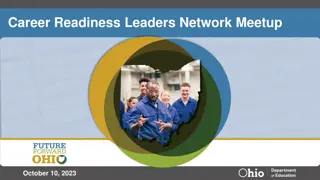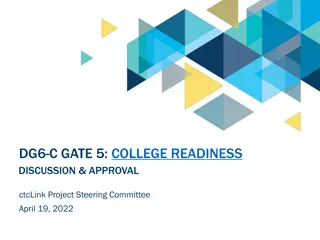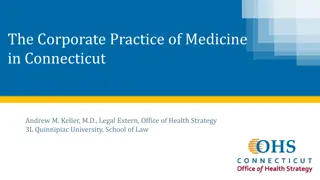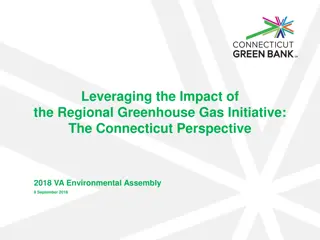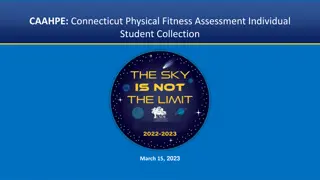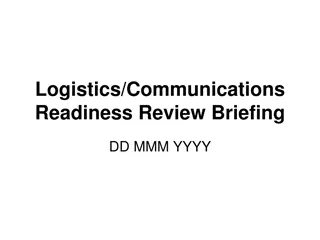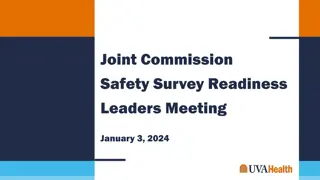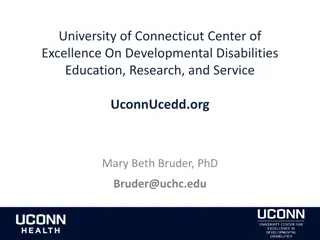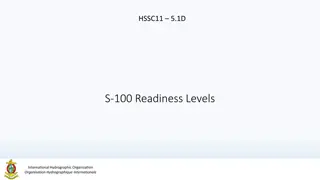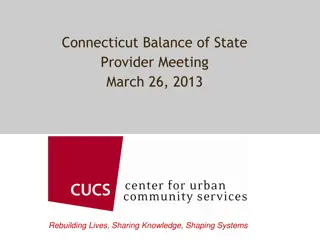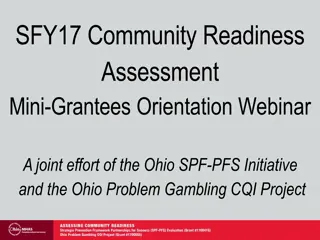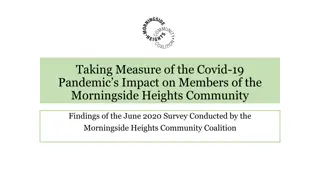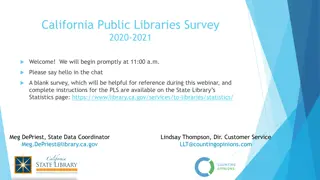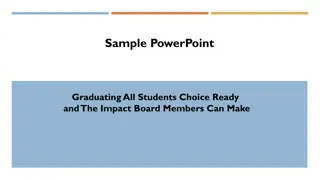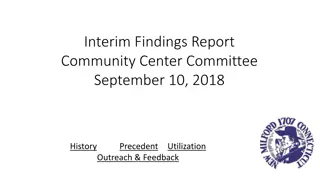Community Readiness Survey 2020 Findings in Connecticut
The Community Readiness Survey (CRS) in Connecticut assesses community attitudes, capacity, and readiness for prevention activities related to behavioral health. The 2020 survey was enhanced to include mental health, suicide, and gambling components, aiming to inform planning and resource allocation at state and regional levels.
Download Presentation

Please find below an Image/Link to download the presentation.
The content on the website is provided AS IS for your information and personal use only. It may not be sold, licensed, or shared on other websites without obtaining consent from the author.If you encounter any issues during the download, it is possible that the publisher has removed the file from their server.
You are allowed to download the files provided on this website for personal or commercial use, subject to the condition that they are used lawfully. All files are the property of their respective owners.
The content on the website is provided AS IS for your information and personal use only. It may not be sold, licensed, or shared on other websites without obtaining consent from the author.
E N D
Presentation Transcript
2020 Connecticut Community Readiness Survey Results: CONNECTICUT A presentation to the DMHAS Resource Links Wednesday, December 2, 2020, 10 am Microsoft Teams Jennifer Sussman DMHAS Center for Prevention Evaluation and Statistics (CPES) at UConn Health
What is the Community Readiness Survey (CRS)? A biennial key informant survey, conducted since 2006, to assess community-level attitudes, capacity, and readiness to implement prevention/health promotion activities relevant to behavioral health; A joint collaboration between the DMHAS, the RBHAOs, the University of Connecticut Department of Public Health Sciences, and the Connecticut Clearinghouse; Key informants were identified regionally by the RBHAOs, with personalized outreach conducted by RBHAOs and DMHAS prevention partners; Results at the state and regional levels are used to inform planning, leverage resources, and inform ongoing prevention efforts. 2
Community Readiness Survey (CRS) Objectives Measure community capacity and readiness for substance misuse prevention and mental health promotion: Community attitudes about alcohol and drug use, mental health issues, suicide and problem gambling; Community support for prevention and health promotion; Perceived barriers to substance abuse prevention and mental health promotion; Ratings of community readiness; Develop a tool and methodology to respond to DMHAS ongoing needs for needs assessment, evaluation; and impact assessment; Inform planning at state and regional levels; Identify needs for training and technical assistance.
The 2020 CRS In response to DMHAS integration of mental health and substance misuse initiatives, the CRS 2020 was re-tooled: The survey was expanded to more fully assess mental health, suicide and gambling attitudes, concerns and readiness; Items were omitted/consolidated to improve accessibility and reduce survey fatigue; Included parallel questions assessing mental health attitudes, concerns, and capacity; Added a 9-point mental health promotion readiness scale; Added items on problem gambling/gaming/sports betting; Content changes were informed by a workgroup comprised of: RBHAOs, community prevention partners, and knowledgeable staff from DMHAS, UConn Health/CPES, and the CT Clearinghouse; Revision of the survey was a data-driven process, informed by item analyses, reliability and validity assessment, and scale testing. Reports Available by State, RBHAO, and Community Type (The Five Connecticuts)
Community Type: The Five Connecticuts The Five Connecticuts are a rubric developed in 2004 by the Connecticut State Data Center as a means of disaggregating Connecticut s 2000 census data in a meaningful way. Five Connecticuts designations are based on criteria of each town s: median household income; population density; and poverty rate Five Connecticut community types: Wealthy Suburban Urban Periphery Urban Core Rural These categories were updated in 2014 using the 2010 census data by the original developer of the designation. The updated designations have been used to categorize data for the Community Wellbeing Surveys since 2015 and the 2018 and 2020 Community Readiness Survey, and are used by others as well. Levy, Don and DataHaven. (2015): Five Connecticuts 2010 Update. Produced for Siena College Research Institute and DataHaven based on the original method of assigning designations used in Levy, Don, Orlando Rodriguez, and Wayne Villemez. 2004. The Changing Demographics of Connecticut - 1990 to 2000. Part 2: The Five Connecticuts. Storrs, Connecticut: University of Connecticut SDC Series, no. OP 2004-01.
Community Types in Connecticut: The Five Connecticuts (5CT) CPES, 2019 6
Community Readiness Survey Response Rates over Time Success! Representation in 166(98%) of 169 Connecticut communities 2006 2008 2010 2012 2014 2016 2018 2020 1236 1019 799 433 479 774 838 746 Respondent N 639 908 1222 1442 1728 1455 1932 2071 Target N 60% 68% 53% 63% 58% 43% 55% 53% Response Rate Response goals met in 117(69%) communities statewide: 91 with population < 40,000 (63.6%) 26 with population 40,000+ (100%)
Key Informant Demographic Characteristics: Connecticut CRS, 2020 n=1,236 12-17 years 1.3 18-25 years 3.5 26-35 years 10.9 Age 36-45 years 19.8 46-55 years 29.1 56-65 years 24.5 66 and older 10.9 Male 27.9 Gender Female 71.5 Non-binary/trans 0.6 White 91.1 Race Black 2.7 Hispanic 4.5 Other 1.7 0 10 20 30 40 Percent Reporting 50 60 70 80 90 100
Key Informant Stakeholder Affiliation: Connecticut CRS, 2020 16.1 Government 7.8 Law Enforcement 3.7 EMS/Rescue/First Responder 23.5 Youth Serving Organization 21.0 Coalition/Council/Task Force 16.3 Social/Human Service Agency 27.4 School 2.9 College/University 6.6 Public Health 12.4 Mental Health Service Provider 5.0 Faith-based Organization 10.2 Substance Abuse Prevention Agency/Provider 3.6 Substance Abuse Treatment Agency/Provider 3.3 Recovery Support Personnel 7.8 Youth 23.9 Parent 16.7 Individual with lived experience* 4.1 Other** 0 20 40 60 80 100 Percent Reporting * Personal or family experience with mental illness, substance misuse, or problem gambling ** Includes: advocate, community member, municipality, philanthropic organization, non-profit, business
Problem Substances of Greatest Concern According to Key Informants By Age Group: Connecticut CRS, 2020 Problem Gambling 4.8 0.1 0.2 0.5 2.4 Prescription drugs 4.3 100 0.4 1.5 16.5 23.4 90 Heroin/Fentanyl 0.0 23.4 36.6 13.3 80 0.8 0.2 Cocaine/Crack 18.2 70 Percent Reporting 0.9 0.2 24.5 60 4.2 Marijuana/Hashish/ THC 2.0 8.5 50 3.1 52.2 Vaping/ENDS 13.3 40 1.9 30 Tobacco/Cigarettes 48.0 47.7 1.9 20 29.5 Alcohol 15.1 10 0 12-17 years old 18-25 years old 26-65 years old 66 or older
Community Attitudes Toward Substance Misuse Prevention: Connecticut CRS, 2020 Key Informant believesthat most community residents . Are concerned about preventing substance misuse 3.12 Believe that youth, regardless of socioeconomic, racial and ethnic status, are at risk of substance misuse 3.32 Know about the community programs that are working to 2.48 prevent substance misuse Feel alcohol and other drug prevention is a good investment for 3.19 the community Believe that prevention programs for youth are effective at preventing substance misuse 2.91 1 2 3 4 Strongly Disagree Somewhat Disagree Somewhat Agree Strongly Agree
Community Attitudes Toward Substance Use: Connecticut CRS, 2020 Key Informant believes that most communityresidents . Are concerned about the legalization of recreational marijuana 2.79 Believe the use of alcohol and other drugs is a private matter that should be dealt with at home 2.22 Think that the occasional use of marijuana is not harmful for 2.36 youth Feel that youth should be able to drink at parties with parental 1.97 supervision Believe that it is okay for teens to drink if they don't drive 1.93 Feel that it is okay for adults to drive after having more than two 2.03 alcoholic drinks Think that it is risky to drink alcohol while taking prescription 2.94 medications 1 2 3 4 Strongly Disagree Somewhat Disagree Somewhat Agree Strongly Agree
Community Attitudes Toward Gambling and Gaming: Connecticut CRS, 2020 Key Informantbelieves that most community residents . Feel that it is okay for youth to gamble with parental supervision (ex. sports betting, scratch-off tickets) 2.23 Think that it is okay to give youth under the age of 18 lottery or 2.63 scratch-off tickets Are concerned that online gaming with in app purchases can 2.53 lead to addiction Are concerned about residents spending more than they can 2.50 afford on gambling Are concerned about older adults, age 65 and older, being vulnerable to gambling problems 2.53 Feel casino expansion is good for the community 2.26 Feel it is okay to expand the lottery to online and in-app play 2.32 1 2 3 4 Strongly Disagree Somewhat Disagree Somewhat Agree Strongly Agree
How would you rate your community s ability to raise awareness about the risks of problem gambling/gaming addiction? How important is it to prevent problem gambling/gaming addiction in your community? High 3.9 Very Important 22.5 Somewhat Important Medium 29.9 39.6 Low 56.9 A Little Important 30.2 No ability 9.4 Not Important 7.7 0 20 40 60 0 20 40 60 Percent Reporting Percent Reporting
Mental Health Issue of Greatest Concern According to Key Informants By Age Group: Connecticut CRS, 2020 Suicide 3.7 3.9 5.6 6.3 100 4.0 10.0 6.3 17.1 14.5 90 Trauma 80 19.6 70 Percent Reporting 37.5 60 Anxiety 58.6 50 86.0 40 64.9 Depression 30 41.8 20 20.3 10 0 12-17 years old 18-25 years old 26-65 years old 66 or older
Mental Health Issue of Greatest Concern for Youth and Young Adults, by Community Type, According to Key Informants: Connecticut CRS, 2020 18-25 12-17 0.8 0.8 3.4 1.0 5.2 100 2.7 0.0 3.6 7.5 7.7 4.4 4.9 100 2.5 1.6 12.3 90 16.3 13.1 90 12.5 80 80 45.8 46.1 70 70 56.3 66.3 37.3 Percent Reporting 34.0 Percent Reporting 60 60 74.6 58.0 93.0 59.7 50 50 21.7 40 40 21.0 30 30 45.7 45.3 44.9 20 20 31.9 29.1 24.0 21.3 19.3 18.3 10 10 6.2 0 0 Rural Suburban Urban Periphery Urban Core Wealthy Rural Suburban Urban Periphery Urban Core Wealthy Suicide Trauma Anxiety Depression
Community Attitudes Toward Mental Health: Connecticut CRS, 2020 Key Informant believes that mostcommunity residents . Are concerned about improving mental health in their 3.07 communities Would support early identification of mental health problems in 3.25 children and youth Are concerned about access to mental health services for 3.11 adults Are concerned about access to mental health services for 3.27 children and youth Believe that mental health problems are a private matter to be 2.34 addressed at home Are uncomfortable discussing the mental health of themselves 3.00 or their families Believe that sufficient mental health supports for students are available in educational settings 2.24 1 2 3 4 Strongly Disagree Somewhat Disagree Somewhat Agree Strongly Agree
Community Support for Suicide Prevention Efforts: Connecticut CRS, 2020 Connecticut 2.82 Wealthy 3.01 Rural 2.72 * Rural communities rank significantly lower than Suburban and Urban Periphery. Suburban 2.91 Urban Periphery 2.95 ** Urban Core communities rank significantly lower than all other community types. Urban Core 2.39 1 2 3 4 No support A little support Some support A lot of support
Community Ability to Implement Suicide Prevention Efforts: Connecticut CRS, 2020 Connecticut 2.73 Wealthy 2.88 *Rural communities rank significantly lower than Suburban and Urban Periphery. Rural 2.65 Suburban 2.83 Urban Periphery 2.84 **Urban Core communities rank significantly lower than all other community types. Urban Core 2.31 1 2 3 4 No ability Low Medium High
Suicide Prevention Supports in Place in the Community: Connecticut CRS, 2020 Key Informant believes that the following are in place in the community . Crisis hotline numbers and other mental health resources visible in 2.28 community locations Support groups in community settings 2.05 Support groups in educational settings 2.14 School personnel trained to recognize warning signs 2.38 Community support groups for specific populations (veterans, law 1.96 enforcement, physicians, others) Regular suicide prevention trainings in community 1.94 Community post-suicide intervention or support plans in place 1.82 1 2 3 Not at All Somewhat Very Much So
Community Readiness to Undertake Behavioral Health Promotion Activities*: Connecticut CRS, 2020 Key Informant believes that the community is ready to . Collect data on the nature of local behavioral health problems 2.89 Identify community members as resources to address behavioral health 3.14 problems Secure support from local policy makers for behavioral health 2.98 Develop culturally appropriate programs and strategies 2.90 Raise community awareness of priority problems or issues (substance misuse, 3.10 gambling, mental health, suicide) Collaborate with organizations concerned with preventing other types of 3.13 problems (HIV, violence) Allocate local funds to address behavioral health problems in the community 2.55 Develop policies related to or to specifically address behavioral health 2.76 problems in the community 1 2 3 4 5 None Very Little Moderate High Very High *Behavioral Health Promotion Activities includes substance misuse prevention and mental health promotion activities.
Key Informant Ratings of the Community Stage of Readiness for Substance Misuse Prevention: Connecticut CRS, 2020 Community Stage of Readiness for Substance Misuse Prevention: Connecticut (n=889) Percent 1 - This town/city tolerates or encourages substance misuse. .9 2 - This town/city has little or no recognition of the substance misuse problem. 3.5 3 - This town/city believes that there is a substance misuse problem, but awareness of the issue is only linked to one or two incidents involving substance misuse. 9.1 4 - This town/city recognizes the substance misuse problem and leaders on the issue are identifiable, but little planning has been done to address problems and risk factors. 24.6 5 - This town/city is planning for substance misuse prevention and focuses on practical details, including seeking funds for prevention efforts. 23.6 6 - This town/city has enough information to justify a substance misuse prevention program and there is great enthusiasm for the initiative as it begins. 7.8 7 - This town/city has created policies and/or more than one substance misuse prevention program is running with financial support and trained staff. 12.5 8 - This town/city views standard substance misuse programs as valuable, new programs are being developed to reach out to at-risk populations and there is ongoing sophisticated evaluation of current efforts. 10.8 9 - This town/city has detailed and sophisticated knowledge of prevalence, risk factors, and substance misuse program effectiveness and the programming is tailored by trained staff to address risk factors within the community. 7.3 Mean Stage of Readiness for Connecticut 5.37
Key Informant Ratings of the Community Stage of Readiness for Mental Health Promotion: Connecticut CRS, 2020 Community Stage of Readiness for Mental Health Promotion: Connecticut (n=895) Percent 1 - This town/city is unsupportive of those with mental health issues. .9 2 - This town/city has little or no recognition of the community s concern about mental health. 5.7 3 - This town/city believes that mental health concerns impact the community, but awareness of the issue is only linked to one or two situations involving mental health. 13.4 4 - This town/city recognizes the mental health concerns of the community and leaders on the issue are identifiable, but little planning has been done to address problems and risk factors. 31.8 5 - This town/city is planning for mental health promotion programs and focuses on practical details, including seeking funds for awareness efforts. 19.8 6 - This town/city has enough information to justify a mental health promotion program and there is great enthusiasm for the initiative as it begins. 7.0 7 - This town/city has created policies and/or more than one mental health promotion program is running with financial support and trained staff. 7.8 8 - This town/city views standard mental health promotion programs as valuable, new programs are being developed to reach out to at-risk populations and there is ongoing sophisticated evaluation of current efforts. 8.9 9 - This town/city has detailed and sophisticated knowledge of prevalence, risk factors, and mental health promotion program effectiveness and the programming is tailored by trained staff to address risk factors within the community. 4.6 Mean Stage of Readiness for Connecticut 4.88 Visit the SEOW Prevention Data Portal: https://preventionportal.ctdata.org/
